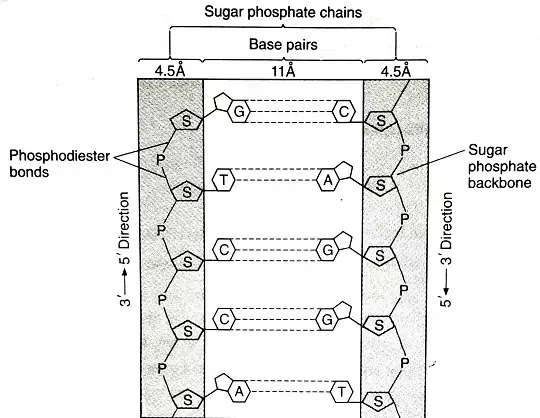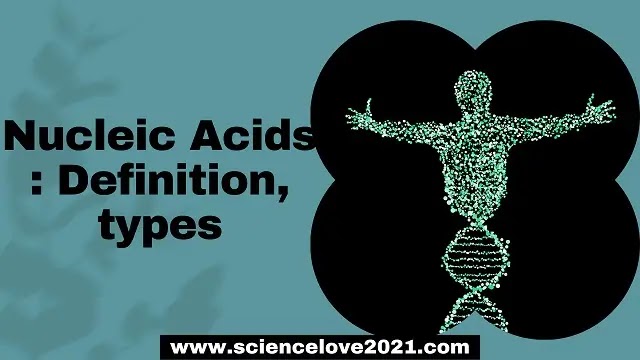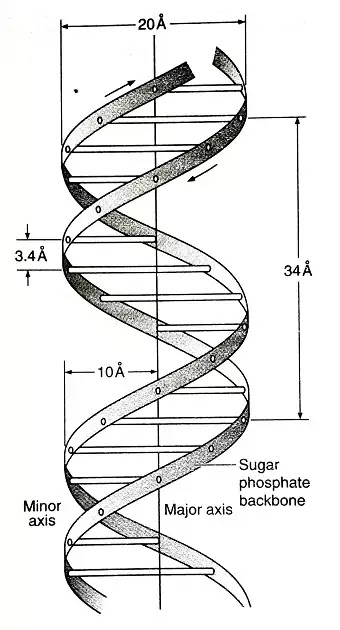Nucleic acids are linear polymeric molecules that are hereditary determinants of living organisms. They were discovered by the Swiss biochemist Friedrich Meischer 1869, which separated them from pus cells. Since the substance was isolated from the nuclei of pus cells, it was called 'Nuclein'. Since nuclein was an acid so Altman was give termed as nucleic acid.
The nucleic acids are the molecular repositories for genetic information and are jointly referred to as the "molecules of heredity". The structure of every protein and ultimately of every cell constituent is a product of information programmed in to the nucleotide sequence of a cell's nucleic acids. Nucleic acids are present in all living organisms whether plants, animals or viruses. Nucleic acids are generally associated with proteins to form nucleoproteins.
The nucleic acids are the molecular repositories for genetic information and are jointly referred to as the "molecules of heredity". The structure of every protein and ultimately of every cell constituent is a product of information programmed in to the nucleotide sequence of a cell's nucleic acids. Nucleic acids are present in all living organisms whether plants, animals or viruses. Nucleic acids are generally associated with proteins to form nucleoproteins.
Properties of Nucleic Acid
1. Nucleic acids are highly complex organic acids, present in all living cells.
2. Nucleic acid was first isolated by F.Meischer (1869) from pus cells. This was actually DNA, but was given the name Nuclein.
3. The name nucleic acid was given to this substance because it occurs primarily in nucleus and is having acidic nature.
4. There are two types of nucleic acids: (i) DNA (Deoxyribonucleic acid), (ii) RNA (Ribonucleic acid).
5. DNA occurs mainly in nucleus, forming major chemical proportion of chromosomes. Some amount of DNA is also present in cytoplasm (in mitochondria and plastids).
6. RNA is mainly found in cytoplasm but some amount of occurs in ribosomes of nucleus, nucleolus and also in chromosomes or chromatin.
7. DNA forms genetic material (hereditary material) of most of the organisms except plant viruses and some bacteriophages, where RNA forms the genetic material RNA mainly performs non-genetic functions related with protein synthesis.
Types of Nucleic acids
There are two types of nucleic acids:-
- Deoxyribonucleic acid (DNA)
- Ribonucleic acid RNA
1. DNA is found in the nucleus while RNA remains in the cytoplasm.
2. A few quantity of DNA is also found in mitochondria and chloroplasts. These conduct protein synthesis and regulate the transmission of hereditary(genetic) components in all the organisms.
3. These are the compounds of 5C. Sugar-Pentase, Phosphoric acid and nitrogenous bases like, Adenine, Guanine, Cytosine, Thymine and Uracil.
4. Every nucleic acid is a multi-compound in which each molecule is made of thousands of units (Uncleotides).
5. Nucleotides are arranged on a strand. Each nucleotide consists of a pentose molecule, a molecule of phosphoric acid and a nitrogenous base.
6. DNA occurs in all the living cells, except plant viruses, which contain RNA as genetic matter.
7. In each cell, the DNA remains concentrated in nucleus, where it forms chromatin network in association with protein.
8. In eukaryotic cells DNA occurs in the form of long spirally twisted un-branched thread. In mitochondria and plastids of eukaryotic cells and in the prokaryotic cell's DNA is circular.
Chemical Composition of DNA
DNA is composed of three types of compounds:
(1) Phosphoric acid
(2) Sugar
(3) Nitrogenous bases
1. Phosphoric acid - Molecular formula of phosphoric acid is H3PO4. It contains 3 monovalent hydroxyl groups and a divalent oxygen atom, all linked to the pentavalent phosphorus atom.
2. Sugars - Two sugars isolated from hydrolysis of nucleic acids both are pentoses, such Ribose and 2-deoxy ribose.
3. Nitrogenous bases - There are two types of nitrogenous bases are found in all nucleic acids. These are-
(i) Purines
(ii) Pyrimidines
(i) Purines - These are of two ringed nitrogenous compound. Two purines are most commonly found in nucleic acids are adenine (A) and guanine (G).
(ii) Pyrimidines - These are of single ringed nitrogenous compound Three Pyrimidines are commonly found in nucleic acids are Uracil, (U), Thymine (T) Cytosine (C).
Molecular Structure of DNA
(ii) Pyrimidines
(i) Purines - These are of two ringed nitrogenous compound. Two purines are most commonly found in nucleic acids are adenine (A) and guanine (G).
(ii) Pyrimidines - These are of single ringed nitrogenous compound Three Pyrimidines are commonly found in nucleic acids are Uracil, (U), Thymine (T) Cytosine (C).
Molecular Structure of DNA
DNA is a macromolecule. Its nitrogenous bases on joining with deoxyribose form nucleosides and with deoxyribose and phosphoric acid form nucleotides.
(A) Nucleosides - A nitrogenous base with a molecule of deoxyribose (without phosphate group) is known as nucleoside. In a nucleoside, the C-1 atom of deoxyribose is linked to the C-1 (in pyrimidines) or the C-9 nitrogen (in purines). Thus, there are four nucleosides in a DNA molecule. (Nucleoside = Pentoes sugar + Nitrogenous base). These are -
1. Adenosine - Adenine + Deoxyribose
2. Guanosine - Guanine + Deoxyribose
3. Cytidine - Cytosine + Deoxyribose
4. Thymidine - Thymine + Deoxyribose
(A) Nucleosides - A nitrogenous base with a molecule of deoxyribose (without phosphate group) is known as nucleoside. In a nucleoside, the C-1 atom of deoxyribose is linked to the C-1 (in pyrimidines) or the C-9 nitrogen (in purines). Thus, there are four nucleosides in a DNA molecule. (Nucleoside = Pentoes sugar + Nitrogenous base). These are -
1. Adenosine - Adenine + Deoxyribose
2. Guanosine - Guanine + Deoxyribose
3. Cytidine - Cytosine + Deoxyribose
4. Thymidine - Thymine + Deoxyribose
(B) Nucleotides - A nucleotide is formed of one molecule of deoxyribose, one molecule of phosphoric acid and one of the four nitrogenous bases. Phosphoric acid molecule is attached to the C-5 atom of deoxyribose ring. (Nucleotide Pentoes sugar + Nitrogenous base + Phasphate). There are four types of nucleotides namely:
Adenine + Deoxyribose + Phosphoric acid
Guanine + Deoxyribose + Phosphoric acid
Cytosine + Deoxyribose + Phosphoric acid
Thymine + Deoxyribose + Phosphoric acid
(C) Polynucleotide chain - DNA is a macromolecule of very high molecular weight. Its monomeres are nucleotides. These are linked in a specific fashion forming a polynucleotide chain. In a polynucleotide chain the adjacent nucleotides are connected adjacent together by phosphodiester bond between phosphate molecule of one nucleotide and C-3 carbon atom of sugar molecule of other nucleotide.
This forms a sugar-phosphate chain. The nitrogenous base is attached to the C-1 first carbon atom of deoxyribose and is directed at right angles to the long axis of polynucleotide chain.
One end of the polynucleotide chain has a sugar residue with C-3 not linked to another nucleotide and the other end with sugar residue C-5 not linked to another nucleotide. These are named as 3' and 5' ends respectively. The chain is not straight but helical in shape.
One end of the polynucleotide chain has a sugar residue with C-3 not linked to another nucleotide and the other end with sugar residue C-5 not linked to another nucleotide. These are named as 3' and 5' ends respectively. The chain is not straight but helical in shape.
Read more - What is Genetic code?
Different Types of DNA
1. B.DNA - It is the most common form of DNA. The Watson-Crick structure described above is of B.DNA. It has 10 base pairs per turn and diameter is 20Å.
2. A-DNA - It is dehydrated form of DNA, which occurs in high salt concentration. It is also right handedly coiled. It has 11 base pairs per turn. Diameter of A-DNA is 26 Å.
3. Z-DNA - It is stable in synthetic double stranded form Z-DNA is left handedly coiled DNA. Nucleotides are arranged in zig-zag manner. One turn is 45Å long. Diameter is 18 Å.
4. c-DNA - It is also called complementary DNA. It is complementary to mRNA molecule and is syntheseised from the later by the action of reverse transcriptase enzyme. It is of great use in genetic engineering.
Watson and Crick double Helix model of DNA
Watson and Crick Model of DNA - In 1953, Watson, Crick and Wilkins produced a functional model of DNA molecule, for which, these were awarded with Nobel Prize. According to the a DNA molecule is made up of a poly-nucleotide chain which has following characteristics-
1. Each DNA molecule is made of two oppositely lying polynucleotide chains.
2. Both the chains are arranged spirally along an axis.
3. The two are coiled in opposite directions where 3' end of a Helix lyres along the 5' end of other.
4. Each coil consists of numerous polynucleotides arranged in series.
5. In each nucleotide, nitrogenous base is attached at inner side of deoxyribose while phosphate molecule is attached on outer side.
6. All the nucleotides of a chain, are joined together with the help of phosphate molecules, this bond is known as phosphodyester bond.
7. Nucleotides of the two coils are joined together with the help of weak hydrogen bonds.
8. The amount of purines and pyrimidines of both the nucleotide chain is equal, because the purines of one chain are united with the pyrimidines of the other. eg: A = T and C = G.
9. Adenine and Thymine are joined with 2 Hydrogen bonds and Guanine and Cytosine with 3 Hydrogen bonds.
10. The distance between the sugars molecules of both chains remains 11Å. The bonds joining nitrogen bases with C-1 atom of sugar join of an angle of 51°.
11. The distance between the two chains (Helix) of DNA remains 20 Å and the distance between any two nucleotides remains 34 Å.
12. A round of coil completes at 34 Å. Each round consists of 10 nucleotides which maintain a distance of 3.4 Å amongst.
13. The two chains (Helix) situated in opposite directions. One consists of C. 3'- 5' direction of sugar and that of other at C 5'-3' directions. Such type of Helix are called as Antiparallel Helix.
 |
| Watson and Crick double Helix model of DNA |
Biological Significance of DNA
1. The replication of DNA is accurate, actual and refined process.
2. DNA is a completely permanent structure; there are few chances of mutations and hereditary alternations.
3. DNA stores all the information regarding organisms.
4. DNA is capable of transformation of above information in the form of characteristics or specific function.
RNA(Ribonucleic Acid)
1. RNA is a genetic messenger.
2. It is a poly ribotide which is made up of small ribotides.
3. Ribose sugar is present inside RNA.
4. Inside RNA there is Ribose Sugar and Nitrogenous base. In which Uracil is present in place of Thymine.
5. The molecule of RNA is small, due to which its molecular weight works with the weight of DNA.
2. It is a poly ribotide which is made up of small ribotides.
3. Ribose sugar is present inside RNA.
4. Inside RNA there is Ribose Sugar and Nitrogenous base. In which Uracil is present in place of Thymine.
5. The molecule of RNA is small, due to which its molecular weight works with the weight of DNA.
Types of RNA
There are three types of RNA -
1. m-RNA (Messenger RNA)
- It is made by DNA and comes out of the nucleus in the cytoplasm and makes different types of proteins by taking orders from the nucleus.
- It is 3-5% of the total RNA of the cell.
- It is produced in the nucleus on the DNA template.
- Its molecular weight is 500,000 to 2000,000.
2. r-RNA (Ribosomal RNA)
- It is attached to the ribosome and specifically helps in the formation of proteins.
- It is 80% of the total RNA of the cell. ,
- It is produced from DNA in the nucleus. It remains active for the longest time among all the three types of RNA.
3. t-RNA (Transfer RNA)
- It is found in the cytoplasm and is of many types. These are small molecules that bring the different types of amino acids needed in protein synthesis to the ribosome where the protein is actually made.
- It is 10-20% of the total RNA of the cell.
- Its molecular weight ranges from 25,000 to 30,000.




No comments:
Post a Comment